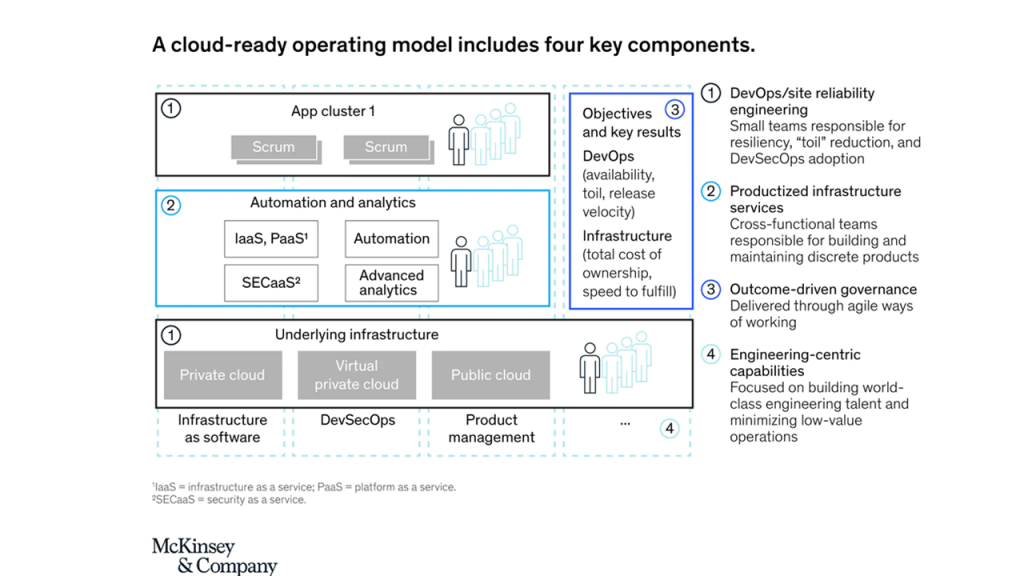Cloud Ready Operating Model
(6 minute read)
Growing customer expectations and exponential developments in technology is making cloud capabilities a strategic imperative for many businesses, regardless of their size.
The cloud market is estimated to reach US$1 trillion by 2025 and the opportunity to tap into a huge potential is up for grabs.
Business however are floundering when it comes to optimising cloud capabilities. They face multiple challenges as their organisational IT models are stuck in legacy technologies, systems, and processes.
If businesses are to overcome these challenges, they may need to step back and consider a holistic approach to their cloud operating model. Adopting a hybrid-cloud appears to be the direction of travel for many businesses. This model has much to offer businesses by way of scale, flexibility, cost efficiencies and reliability. Failing to achieve that brings with it risks of not being able to meet growing customer demands.
If the goal of a hybrid-cloud model is to be realised however, businesses will have to radically re-imagine their IT infrastructure. Done well, it can benefit businesses by expanding access to new services and products, accelerate time to market for applications, cut operating costs, and foster innovation.
Four Challenges and Four Solutions
McKinsey identifies four key challenges faced by organisations and four possible solutions in driving a hybrid-cloud model goal.
- Legacy Issues: Many businesses face legacy issues in their IT infrastructure and operating models which are mainly manual-intervention-based. Many operating and maintenance tasks are performed manually, slowing down processes, and risking critical incidents caused by human error.
- Lack of Ownership: Legacy systems are characterised by lack of clarity around ownership and responsibilities, creating uncertainty, which in turn travels down the line on to customers in the form of delays and poor service.
- Skewed Metrics: Organisational IT-related service metrics are often misaligned with performance outcomes. Metrics are set based on individual and team outputs and resources are allocated based on volume of activity. This skews metrics towards process activities instead of performance outcomes.
- Little Emphasis on Engineering: Legacy systems often privilege operations at the expense of engineering capabilities, leaving very little support for technical improvements and capability building.

Based on specific organisational circumstances and objectives, four suggestions are offered to help organisations build a new cloud-ready, infrastructure-driven IT operating model.
Site Reliability Engineer SRE Model: Building and adopting an SRE model will help organisations bring together application development, operations, and infrastructure services. SREs can balance engineering and operational responsibilities and can work across application development and infrastructure functions. From operational standpoints they can monitor service level objectives and performance metrics efficiently, adopting systems and process improvements such as security updates and releases, mitigating system vulnerabilities, eliminating delays and cost overruns. From engineering standpoints, they can monitor infrastructure for reliability, scalability, and continuous delivery and strategic capacity planning. As organisational infrastructure matures, the boundaries between applications, clusters, development, and infrastructure blurs and becomes embedded.
Infrastructure as Product-Service: Organisations should aim for agile product teams that consist of people with across-the-board expertise who can develop product-services based on infrastructure that will be readily consumed rather than waste time developing products no one needs. Examples can include service improvements, service catalogues, and other infrastructure-asset based spin-offs such as full lifecycle products, virtual servers, storage capacity, or other automated services. This enables organisations to monetise their cloud capacity.
Outcome-Driven Governance: Systematic setting of Objectives and Key Results (OKRs) via metrics will enhance accountability. Metrics need to be set and measured against a combination of business outcomes and customer adoption. Goals can be a mixture of vertical – top down and bottom up, combining organisational and business goals with team level goals; horizontal goals – tangible stretch goals that push and challenge teams beyond their stated capacity; and right tools to support and measure outcomes.
Engineering Capabilities: Organisations need to invest in augmenting engineering talent by way of skills, knowledge, expertise over processes, and product ownership. Talent development needs to be managed through both internal capacity building and recruiting external talent as well as opening up cross-training opportunities.

